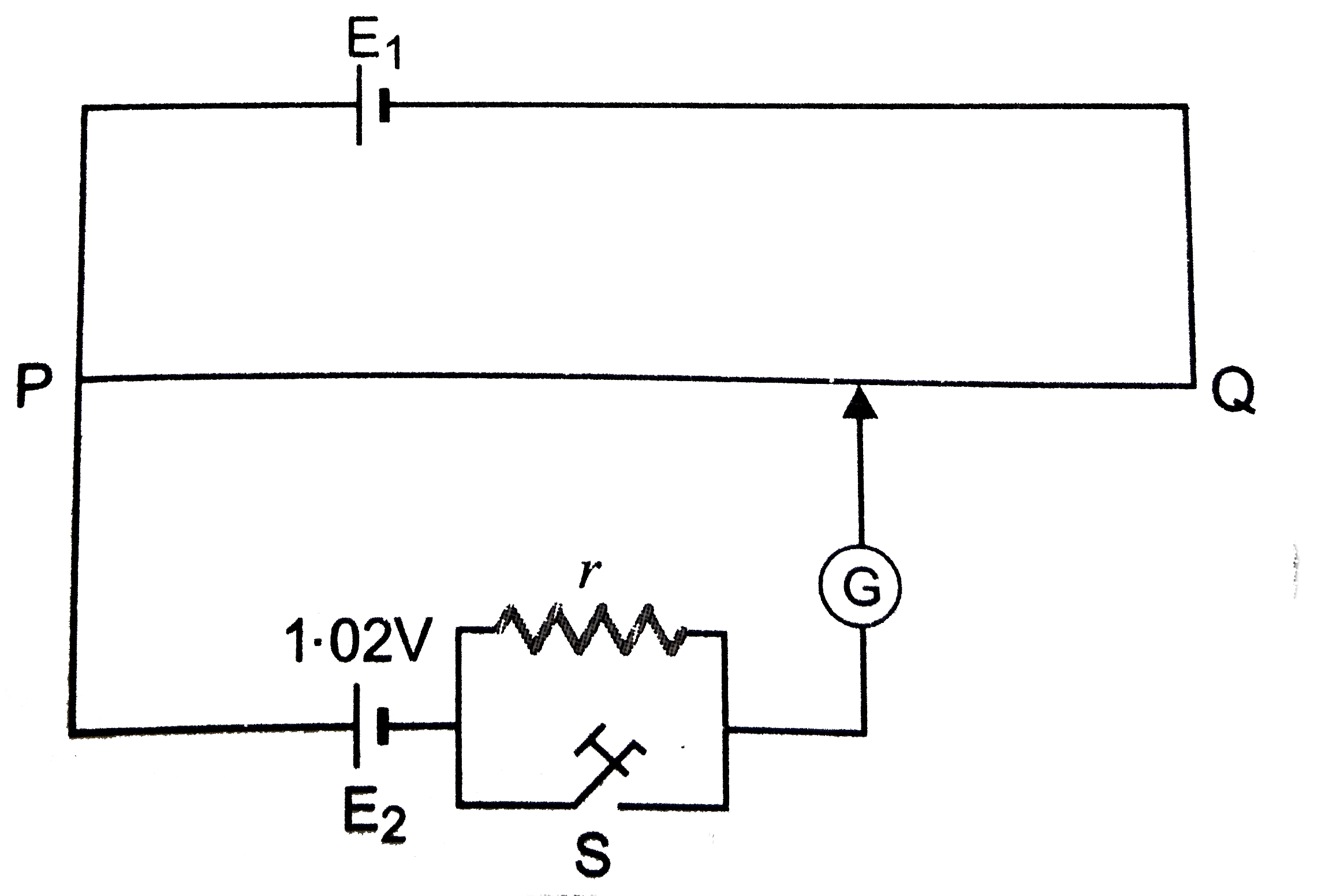The potential gradients on the potentiometer wire are V1 and V2 with an ideal cell and a real cell of same emf in the primary circuit, then
V1=V2
V1>V2
V1<V2
V1≤V2
The correct Answer is:B
Step by step video, text & image solution for The potential gradients on the potentiometer wire are V_(1) and V_(2) with an ideal cell and a real cell of same emf in the primary circuit, then by Physics experts to help you in doubts & scoring excellent marks in Class 12 exams.
Topper's Solved these Questions
- BOOK - NARAYNACHAPTER - EXPERIMENTAL PHYSICSEXERCISE - Level-v(Single answer)23videos
EXPERIMENTAL PHYSICS
- BOOK - NARAYNACHAPTER - EXPERIMENTAL PHYSICSEXERCISE - Multiple answer6videos
EXPERIMENTAL PHYSICS
- BOOK - NARAYNACHAPTER - ELECTROSTATICS AND GAUSS LAWEXERCISE - Intergers type question11videos
ELECTROSTATICS AND GAUSS LAW
- BOOK - NARAYNACHAPTER - MAGNETISMEXERCISE - LEVEL-II (H.W)24videos
MAGNETISM
Similar Questions
A cell with considerable internal resistance is connected directly across the terminals of the potentiometer wire. The potential gradient is now 'G'. Now the potentiometer wire is replaced by another wire of same material but double the length and having the same radius as that of the original wire. The new potential gradient on the wire with the same cell connected as before is (A) G/2 (B) G (C)
View SolutionPotentiometer wire PQ of 1m length is connected to a standerd cell E1. Another cell, E2 of emf 1.02V is connected with a resistance r and a switch S open, null position is obtained at a distance of 51cm from P Calculate (i) potential gradient of the potentiometer wire and (ii) emf of the cell E1 (iii) when swich S closed will mull point move toward P or toward Q ? Given resion for your answer ?
 View Solution
View Solution
Knowledge Check
- Question 1 - Select One
The balancing length on a potentiometer wire with a cell of emf 2V and internal resistance 1Ω connected in the secondary circuit with no load is 200cm. If a resistor of 19Ω is connected parallel to the cell, the balancing length
Adecreases by 10%Bdecreases by 20%Cdecreases by 5%Ddecreases by 10% - Question 2 - Select One
is made of uniform material and cross-sectional area, and it has uniform resistance per unit length. The potential gradient depends upon the current in the wire.
A potentiometer with a cell of emf 2V and internal resistance 0.4Ω is used across the wire AB. A standard cadmium cell of emf 1.02V gives a balance point at 66cm length of wire. The standard cell is then replaced by a cell of unknows emf e (internal resistance r), and the balance. Point found similarly turns out to be 88cm length of the wire. The length of potentiometer wire AB is 1m.
The reading of the potentiometer, if a 4V battery is used instead of e isA88.3cmB47.3cmC95cmDcannot be calculated - Question 3 - Select One
A potentiometer is an ideal voltmeter since a voltmeter draws some current through the circuit while potentiometer needs no current to work. A potentiometer works on the principle of emf comparison. In working condition, a constant currant flows throughout the wire of a potentiometer is made of uniform material and cross-sectional area, and it has uniform resistance per unit length. The potential gradient depends upon the current in the wire.
A potentiometer with a cell of emf 2V and internal resistance 0.4Ω is used across the wire AB. A standard cadmium cell of emf 1.02V gives a balance point at 66cm length of wire. The standard cell is then replaced by a cell of unknows emf e (internal resistance r), and the balance. Point found similarly turns out to be 88cm length of the wire. The length of potentiometer wire AB is 1m.
The value of e isA1.36VB2.63VC1.83VDnone
A 10 metre long potentiometer wire carries a steady current. A 1.018 volt standard cell is balanced at a length of 850 cm. find (i) the potential gradient along the wire and (ii) the maximum emf that can be measured.
View SolutionA 10 wire potentiometer has first five wires of cross sectional radius r and next five wires of radius 2r. The wires are uniform and made of same material. An ideal cell of emf 2V is connected across the potentiometer wire. What length of the potentiometer wire will balance the emf of–
(a) a Daniell cell (emf = 1.0 V)
(b) a Lechlanche cell (emf = 1.5 V)
(c) a cell of emf 1.8 V ?
Length of each wire is 100 cm.View SolutionIn a potentiometer circuit, the emf of driver cell is 2V and internal resistance is 0.5Ω. The potentiometer wire is 1m long . It is found that a cell of emf 1V and internal resistance 0.5Ω is balanced against 60 cm length of the wire. Calculate the resistance of potentiometer wire.
View Solutionis made of uniform material and cross-sectional area, and it has uniform resistance per unit length. The potential gradient depends upon the current in the wire.
A potentiometer with a cell of emf 2V and internal resistance 0.4Ω is used across the wire AB. A standard cadmium cell of emf 1.02V gives a balance point at 66cm length of wire. The standard cell is then replaced by a cell of unknows emf e (internal resistance r), and the balance. Point found similarly turns out to be 88cm length of the wire. The length of potentiometer wire AB is 1m.
If the resistance is connected across the cell e, the balancing length willView SolutionIn an experiment to find the internal resistance of a cell by a potentiometer, a balance was obtained for 50 cm length of the potentiometer wire, with a cell of e.m.f. 2V. When the cell was shunted by a resistance of 2Ω, the balancing length of the potentiometer wire was 40 cm. What was the internal resistance of the cell ?
View Solution

